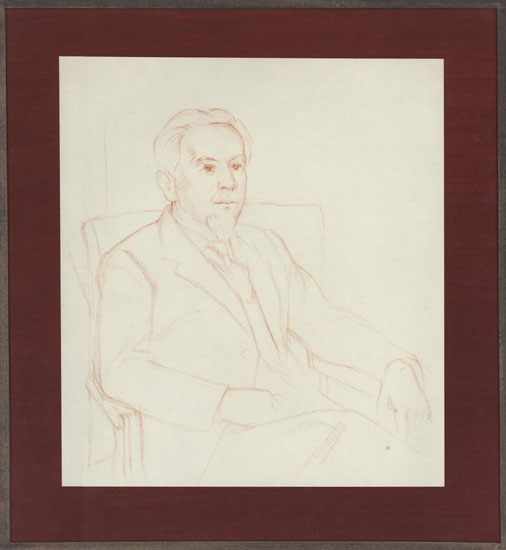
 SOLD
SOLD
Percy Horton:
Portrait of James Fitton, circa 1950
Passe-partout (ref: 4992)
Red chalk
30 x 27 cm ( 39 x 36 cm framed )
Tags: Percy Horton chalk
Both Horton and Fitton lived in Dulwich. Known as a painter and designer, Fitton, (1899-1982) was born in Oldham, the son of an iron plater and union leader, and a mill weaver. He was educated at the Watersheddings Board School until 1913, having learnt to draw after losing time at school after a bungled operation which left him partly deaf. Fittons’ father was involved in the Fabians, and through this Fitton met James Keir Hardie and Emmeline Pankhurst. Fitton worked for six year sorting textile samples in Manchester, whilst attending Manchester Art School in the evenings. He was taught by Adolfe Vallette, one time assistant to Degas, and Sam Rabin and L.S. Lowry (with whom he drew the countryside) were fellow students.
Fitton went to London in 1921, where he was employed by the printer J. S. Riddell for eighteen months. Fitton learnt his trade on the job, although he left when offered the opportunity to design a large mural. Afterwards, one of his jobs involved designing a poster for the Russian trade delegation, which brought him under police observation just before the Arcos raid. Fitton designed oil paintings for film stills, then worked for two years as an illustrator on an adventure magazine, which gave him time to visit London museums. In 1935 he attended evening classes in lithography at the Central School of Arts and Crafts, and ‘became absorbed in the world of young London artists’.
In 1928 he married Margaret Cook, a fellow student, and painter and illustrator. Moving near Dulwich, Fitton took a job with a small advertising agency, Vernon’s. In 1930 he was appointed Art Director of Vernon’s, a post he held for fifty years converting it into one of the most successful pre-war advertising agencies. The same year he also became a member of the New English Art Club, the London Group, and the Senefelder Club. Fitton, along with Misha Black, James Boswell, James Holland, Pearl Binder and Clifford Rowe were founders of the AIA in 1933. Those in the AIA were ‘appalled by mass unemployment, Nazi aggression, and the threat of war, and inspired to action by the graphics of Krokodil, Simplicissimus, and the drawings of Grosz’. The AIA produced cartoons, posters, banners, pamphlets, and exhibitions, and ‘by 1935 virtually all respected London artists had become members’. The revival of satirical drawing was initiated by cartoons drawn, from 1934, by ‘the three Jameses’ in the Left Review. This revival continued through the war, and ‘led to a new age of British caricature exemplified by Gerald Scarfe and Ralph Steadman’. Fitton was therefore already well known before the war as a left-wing cartoonist, and had done designs for the Empire Marketing Board (EMB).
Fitton was not a modernist, but was sympathetic to advanced European Art, and was one of few British artists ‘who revolutionised commercial graphics by an infusion of modernism, and brought the art of the poster to a peak in the 1930s’. Fitton was commissioned by Frank Pick in 1937 to design two posters for London Transport and, in 1938, murals for the United Kingdom government pavilion at the Empire Exhibition in Glasgow. He undertook free-lance magazine and newspaper illustration work in the 1940s, and produced many designs for the MOI and MOF in the Second World War . He was also the chief assessor for the Ministry of Education diploma in design from 1940 to 1965 at the Royal Academy.
Information taken from: Darracott, J. and Loftus, B., Second World War Posters, 1981, p.27; Campbell, p.155; and Gore, F., ‘Fitton, James’, National Biography, 1990. (Taken from the IHR Database.)







